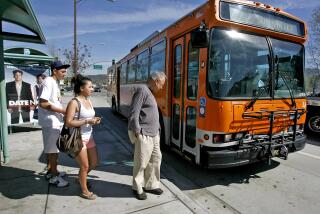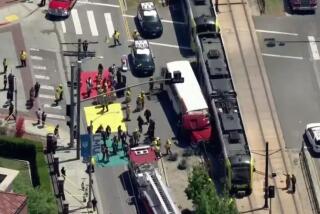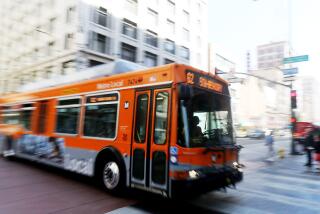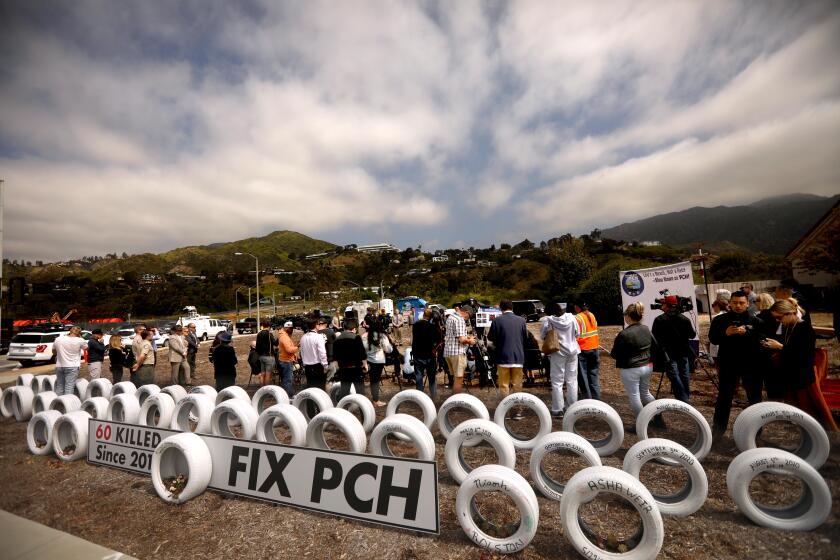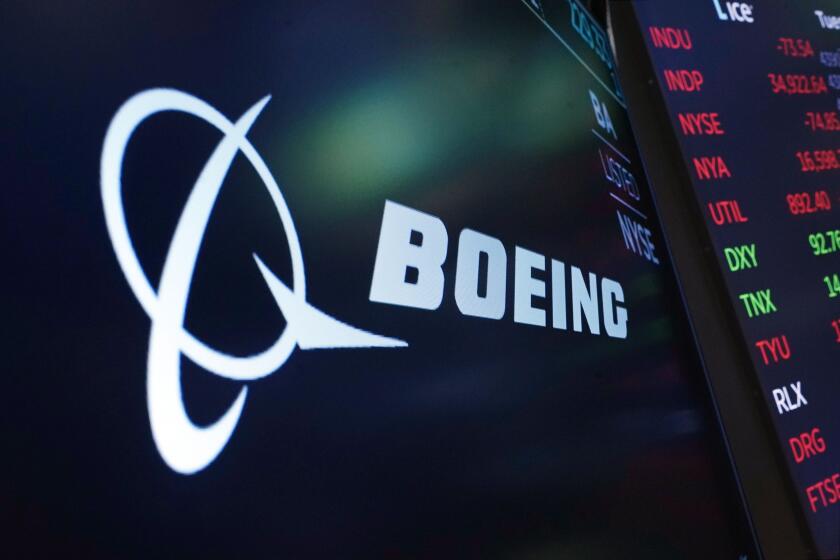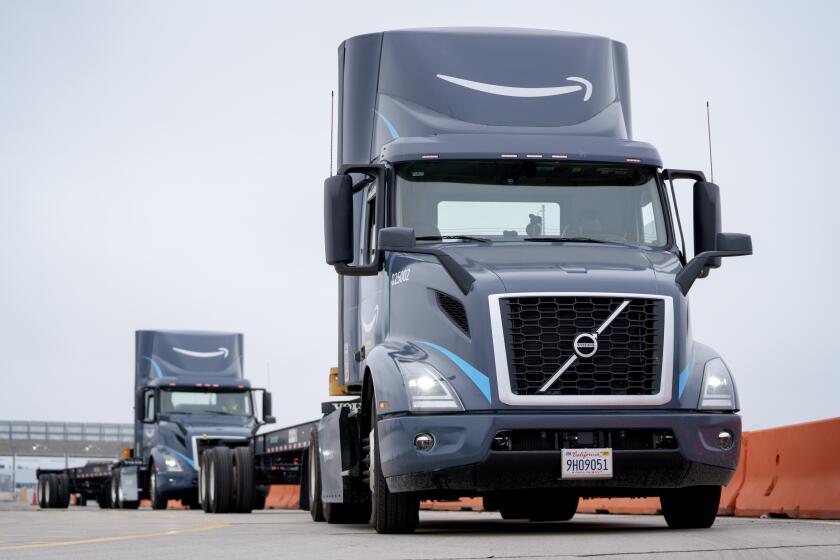500,000 Affected by MTA Strike : Labor: Walkout by mechanics is honored by drivers and clerks, taking 85% of buses off streets. No further talks are scheduled.
Los Angeles staggered to work Monday, car-pooling, hailing cabs, hitchhiking and even walking on the first day of a bus and train strike that left more than half a million riders desperately searching for other modes of transportation.
The walkout by the Metropolitan Transit Authority’s 1,900 mechanics--honored by 5,000 bus and rail drivers and transit clerks--came after talks on a new contract broke down between the MTA and the mechanics union late Sunday night. Although unions representing the drivers and clerks reached tentative last-minute contract agreements, they decided to support the mechanics’ strike.
It was the first shutdown of the nation’s second-largest transit system since 1982, when drivers walked off the job for five days. It was a day of aggravation, uncertainty, sore feet and occasional violence by striking workers who viewed themselves as pawns in the MTA’s desperate effort to balance its annual budget of nearly $3 billion.
In Beverly Hills, three striking drivers attempted to hijack an MTA bus driven by a temporary driver about noon, police said. The suspects boarded the bus and threatened the driver with violence while the sole passenger aboard fled, said Lt. John Dunkin, an LAPD spokesman. Two were arrested.
The strike’s full effect on traffic was not expected to be felt until today, when more bus and train riders, having more time to plan, turn to cars. “A lot of people just didn’t go to work; some people just got scared off,” said Jerry Baxter, director of the local Caltrans office.
At the MTA yard in Sun Valley, about 30 strikers--some with children and dogs in tow--showed up to heckle supervisors and the others who drove the few MTA buses on the streets.
Spirits were high as they hoisted homemade signs and booed the drivers, reserving special venom for service inspectors, who normally board buses at random to check on whether the regular drivers are observing all regulations. But when a popular supervisor was at the wheel, the taunts were more in fun than anger.
Some strikers apparently wondered whether the tone was too lighthearted, lacking the usual militant union touches. “Maybe we should all be yelling ‘scab’ or something like that when the buses go by,” a striker suggested at one point.
On Day 1:
* Riders waited for hours in vain as only about 15% of the buses hit the streets. Because the strike was not called until after midnight, many riders were unaware of it until they showed up at their bus stops. Only about 313 buses--compared to the normal 1,200--rolled on the 30 busiest routes and service was limited to between 6 a.m. and 6 p.m. Substitute buses included yellow school buses driven by private drivers hired by the transit agency at a total cost of $160,000 a day. White paper covered the word school and the MTA’s “circle M” symbol was added to the front, sides and rear of the buses. As the news sunk in, some called taxicabs, which reported booming business. Some raised their thumbs and tried to hitchhike, drawing occasional cooperation from commuters. Others called friends, and many simply gave up and went home. Moaned one San Fernando Valley rider: “I have to pray for a ride.”
Riders waited, both patiently and impatiently, for buses to appear at San Fernando Valley stops. By 7:45 a.m., more than 50 people crowded three stops at Van Nuys and Ventura boulevards in Sherman Oaks, a major transfer point.
At Van Nuys and Roscoe boulevards in Panorama City, a man waiting at a stop shouted to a friend in a passing car: “Come on, man, I’ve been waiting three hours!”
Lou Cline and his wife finally gave up waiting and started to walk home from the stop on Sepulveda Boulevard and Vose Street.
“Every day we take two buses to the senior center at Victory and Coldwater,” said Cline, 85. “We have our friends there, have a little fun, a little entertainment.” Now, they said, they must stay home until the buses begin running again.
Pedro Ocampo was at the pay phones at Saticoy Street and Sepulveda telling his boss he was not going to be able to work Monday.
“I work in San Fernando, and I don’t have a way to get there,” said the 37-year-old gardener. “I’ll just have to see about getting a ride there tomorrow.”
* No further negotiations were scheduled. There were signs that the strike could be prolonged because the main sticking point--the transit agency’s desire to contract out some work now done by unionized mechanics--is a life-or-death issue to organized labor in many sectors of the economy. Complained Los Angeles Mayor Richard Riordan, an MTA board member: “The mechanics, representing less than a third of the (striking) work force, have disrupted the lives of hundreds of thousands of Angelenos--all in order to preserve archaic work rules that reward inefficiency and cost taxpayers millions of dollars.”
Responded Joe Drouin, a shop steward for the Amalgamated Transit Union, who was walking on a picket line outside a bus yard in Downtown Los Angeles: “We’re fighting for our livelihood.”
* The lack of buses caused unusually high absenteeism in schools across the city.
At Monroe High in North Hills, there were 160 pupils absent out of 1,300. Just 13 students showed up in one class of about 30.
“A day in summer school--because of the focus and concentration--is like the equivalent of five (regular) school days,” said Thane Opfell, Monroe assistant principal. “If we have kids out five days, that would be very hard to get caught up.”
* The attempted hijacking by striking drivers was the harshest action of the day. It was foiled when police officers noticed the bus pulled over in an odd spot near Wilshire and San Vicente boulevards and boarded it. Five-year MTA driver Benjamin Leyva and seven-year driver Ace Brawner, both of Los Angeles, were arrested and booked on suspicion of robbery. Police are seeking the third suspect, who fled. “We don’t advocate this; we don’t condone it. We certainly regret it,” said Goldy Norton, spokesman for the United Transportation Union. “Sometimes people just do things they shouldn’t do. We think it’s absolutely the wrong thing to do.” The MTA reported 40 acts of vandalism against buses and property Monday. The city’s Department of Transportation reported that eggs and rocks were also thrown at DASH buses and that a rock broke the windshield of a Commuter Express bus.
On the Streets
At street corners throughout town, despair set in early among the transit-dependent who make the vast majority of the 1.2 million daily boardings of MTA buses.
Bea Alexander, who lives in Hollywood and works Downtown as a secretary, was fuming as she sat in a friend’s house, waiting for a car ride that would get her to work hours late.
Alexander, a regular MTA bus rider on a line that runs on Sunset Boulevard, said she watched the 11 p.m. news Sunday night to see whether there was a strike, saw that it was still up in the air, then went to bed and rose to get to her regular bus stop at 6:45 a.m.
She waited 20 minutes. Then another rider, listening to the news on a radio with headphones, found out about the strike.
Alexander said she was mad that MTA had not provided any alternate bus service on Sunset, a main artery toward Downtown.
“I stood out there with a woman with a walker who was trying to get to a doctor. I don’t understand what people think we’re going to do--jump in our Mercedes? Call a friend at 5:30 (a.m.) and say, ‘Pick me up?’
“People who ride the buses, we’re already challenged--disabled people, elderly people, handicapped people, hard-working people who get up at 5 a.m. to get a 6 a.m. bus. To stand out and get treated like this because we don’t own a car--in a city where no one should own a car--is ridiculous.”
In West Los Angeles, Santa Monica office manager Joyce Cohan waited 20 minutes at a bus stop before she learned of the work stoppage.
“It’s going to be a problem,” she said. “I have no other way to get to work.”
After waiting an hour in Wilmington for a bus that never arrived, Holson Chang Lee walked 4 1/2 hours before he reached his Crenshaw home.
The security guard, who got off work at midnight, reached home at 5:30 a.m. At 8 a.m., he once again waited for a ride, this time to take him to the bank so he could withdraw $1,600 to purchase a car.
Groping for Alternatives
Commuters left stranded by the strike were desperately calling taxicab companies in unprecedented numbers, often from bus stops and street corners. Some taxi dispatchers reported their business was double that of a normal workday.
“Well, (the strike) might be bad news to the bus riders, but not to the taxi drivers,” said Belinda Esnayra, a public service agent for Checker Cab Co., whose business shot up 40% during the morning commute. “It’s amazing how many people depend on the bus.”
Still, the wait for a taxi was often more than an hour during rush hour, and cab fares were a far cry from $1.10 bus rides.
“We are very, very busy,” explained Mae Caringal, a secretary at United Independent Taxi who was helping out with dispatching Monday morning because of the extra workload. All 231 drivers were on the road Monday instead of the usual 100 at a time, she said.
People on street corners even tried to flag down the Skycar service, which mainly drives travelers to LAX, said dispatcher Tylee James.
“There are a lot of very desperate-sounding people who’ve got to get to work, got to get somewhere, and don’t have buses to do that,” James explained, adding that his drivers are trying to help out as much as they can.
MTA board member John Fasana asked employers to be tolerant.
“We’re urging all employers to cut a little extra slack for their employees today. It may be a little difficult for them to get to work,” he said. “We’re asking everybody to try to help each other out over these next few days.”
Riders on the regular MTA buses were charged 50 cents. Passengers on school buses rode for free because the buses have no fare collection equipment.
The bus system will operate only from 6 a.m. to 6 p.m in the initial days of the strike. Service on the Metro Red and Blue Lines will be virtually unaffected, but the trains will operate only on weekdays from 6 a.m. to 6 p.m.
Blue Line trains that ran from Downtown Los Angeles stopped at the Willow Street station in Long Beach instead of continuing to the southern terminus in Long Beach. Long Beach buses ferried train riders to the end of the line.
The Negotiating Stalemate
Contracts between the MTA and its three major unions expired June 30. The transit agency reached a tentative agreement at 3:15 p.m. Sunday with the United Transportation Union representing drivers and at 2 a.m. Monday with the Transportation Communications Union representing clerks.
But the Amalgamated Transit Union and the transit agency remained at loggerheads over the issue of subcontracting.
MTA officials want to contract out work now performed by union mechanics, such as making parts.
At a news conference at MTA headquarters Monday, officials said it costs the agency more to have union workers make dustpans and mop buckets than to buy them at a store.
Union mechanics are skeptical of the transit agency’s assurances that no employees will be laid off. They regard subcontracting as a union-busting tactic and say it could reduce their wages and result in poorer quality work.
“They put subcontracting on the table, which is definitely something we are not going to agree to--that’s taking away our work and giving it to other people,” said Mike Bujosa, president of the local chapter of the Amalgamated Transit Union.
MTA chief negotiator Gordon Krischer said, “There are items that we can purchase for less outside than it costs to make inside.” He said that under the proposal on the table, union mechanics would be given an opportunity to bid on the work. “Let our own employees bid on this work,” he said.
The union also opposes the MTA’s desire to reduce the hourly wage for newly hired mechanics.
Nevertheless, the strike appeared to be affecting the Los Angeles Unified School District’s summer program, in which about 65,000 students are enrolled.
Idelle Thaler, assistant principal of Birmingham High School in Van Nuys, said she was advising students “to call up all their friends and neighbors and family members--cousins, aunts and uncles--to try to get a ride here. “The vast majority of these kids are here for very specific reasons and this is very difficult on them.”
* A DAY OF WAITING: There was no outbreak of panic in the Valley, but people were running a bit late. B1
* BUS SERVICE: Emergency service has been set up on seven of the Valley’s busiest routes. Map, B4
More to Read
Start your day right
Sign up for Essential California for news, features and recommendations from the L.A. Times and beyond in your inbox six days a week.
You may occasionally receive promotional content from the Los Angeles Times.
